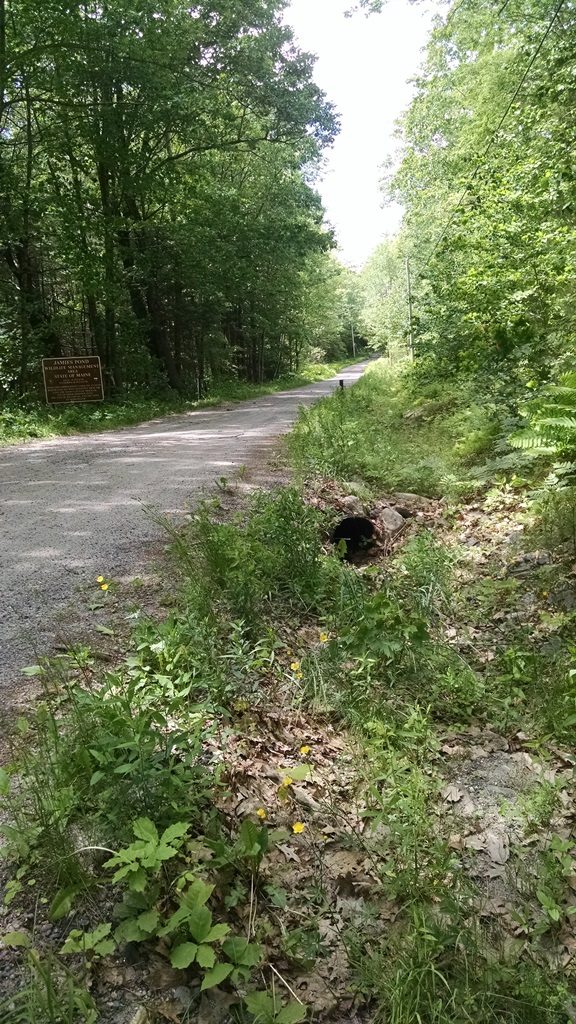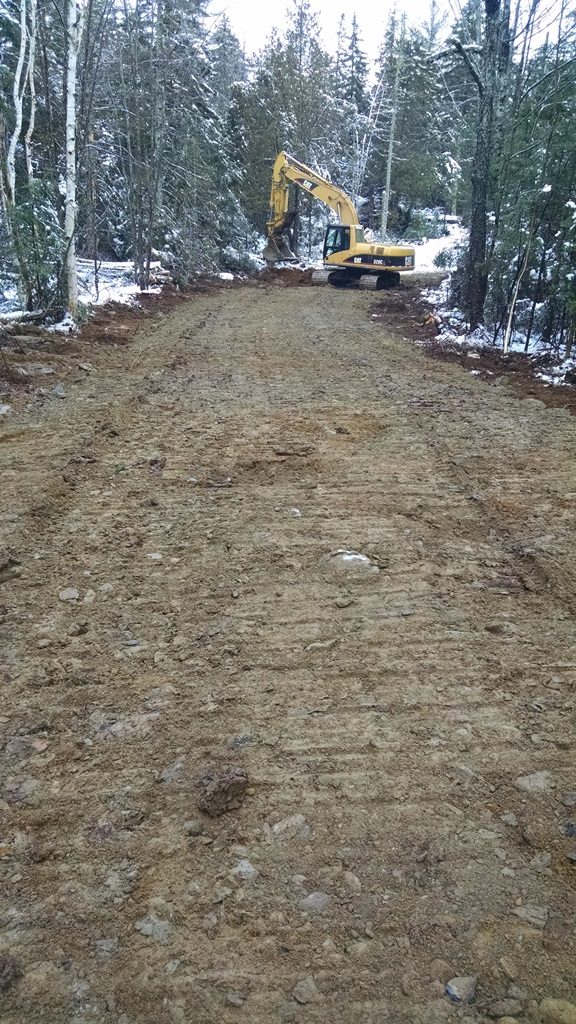June 14, 2016 at 4:51 pm
 Road construction on Wildlife Management Areas is by nature a delicate balancing act. A great deal of thought goes into the location and length of a road since once it has been constructed it will likely remain a gap in the landscape in perpetuity, but is necessary both for access and also for habitat work.
Road construction on Wildlife Management Areas serves two purposes. The first is for public access. Public access roads are typically built to a high standard, are well ditched and crowned to ensure proper drainage, and graveled for soil stability that reduces erosion and siltation. At right is a picture of Jamie’s Pond Road in Hallowell showing a good crown, ditch and culvert facilitating effective drainage. These roads are generally open for public use following Maine’s spring mud season through muzzle-loader season and occasionally the general trapping season depending on the stability of the road, and the nature and frequency of public use.
The second type of road constructed on Wildlife Management Areas is a management road. Management roads are built both for summer and winter access with the primary difference being the type of material used in their construction. Summer roads are generally graveled unless the material they are constructed from is stable enough to prevent erosion. Winter roads are constructed from whatever material is present on site, and frequently includes snow and debris that freezes and binds the material together. Below is a picture of a winter road being constructed with an excavator. After use has concluded, management roads, particularly winter roads, are nearly always closed and seeded with a mix of grasses and clovers because they are not designed to withstand steady vehicular use. They are also closed to prevent illegal dumping and partying, both of which are a problem for many landowners both public and private. All roads are open to foot traffic allowing access for fishing, hunting, trapping and hiking.
Road construction on Wildlife Management Areas is by nature a delicate balancing act. A great deal of thought goes into the location and length of a road since once it has been constructed it will likely remain a gap in the landscape in perpetuity, but is necessary both for access and also for habitat work.
Road construction on Wildlife Management Areas serves two purposes. The first is for public access. Public access roads are typically built to a high standard, are well ditched and crowned to ensure proper drainage, and graveled for soil stability that reduces erosion and siltation. At right is a picture of Jamie’s Pond Road in Hallowell showing a good crown, ditch and culvert facilitating effective drainage. These roads are generally open for public use following Maine’s spring mud season through muzzle-loader season and occasionally the general trapping season depending on the stability of the road, and the nature and frequency of public use.
The second type of road constructed on Wildlife Management Areas is a management road. Management roads are built both for summer and winter access with the primary difference being the type of material used in their construction. Summer roads are generally graveled unless the material they are constructed from is stable enough to prevent erosion. Winter roads are constructed from whatever material is present on site, and frequently includes snow and debris that freezes and binds the material together. Below is a picture of a winter road being constructed with an excavator. After use has concluded, management roads, particularly winter roads, are nearly always closed and seeded with a mix of grasses and clovers because they are not designed to withstand steady vehicular use. They are also closed to prevent illegal dumping and partying, both of which are a problem for many landowners both public and private. All roads are open to foot traffic allowing access for fishing, hunting, trapping and hiking.
 The Lands Program’s purpose is to support regional wildlife management efforts and create, maintain and enhance wildlife habitat. Roads allow access into an area where habitat work is accomplished but by themselves offer very little other than a means of ingress and egress. Exceptions include forage for various species, and cover for ground nesting songbirds for a period of a few years.
The Lands Program’s purpose is to support regional wildlife management efforts and create, maintain and enhance wildlife habitat. Roads allow access into an area where habitat work is accomplished but by themselves offer very little other than a means of ingress and egress. Exceptions include forage for various species, and cover for ground nesting songbirds for a period of a few years.
Categories